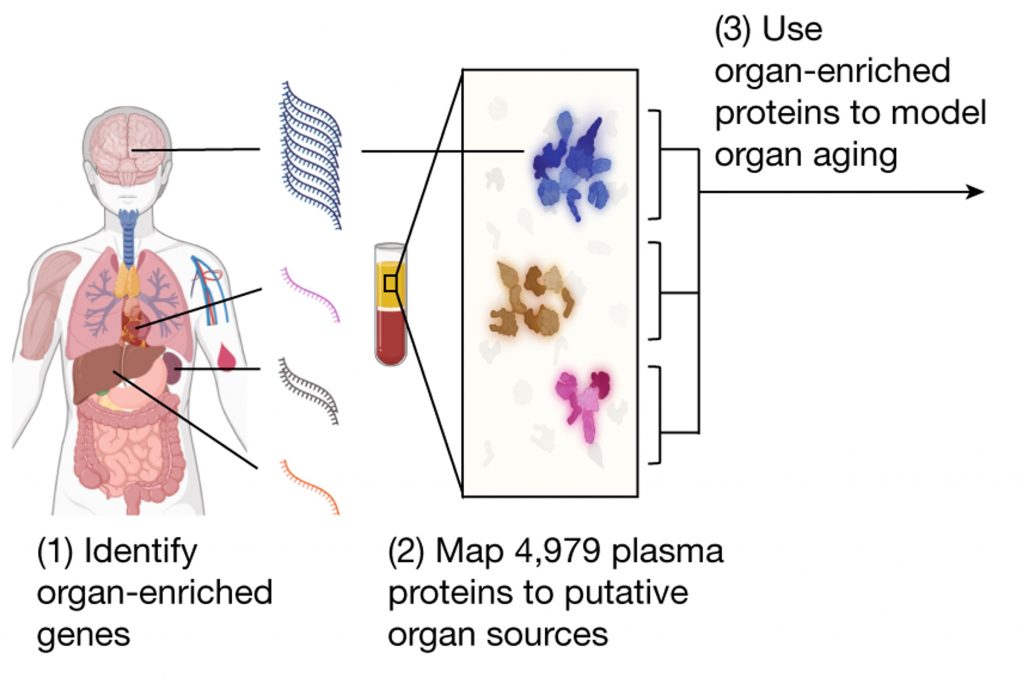Key Points:
- Organ age was determined using organ-specific proteins from human blood samples.
- Organ aging varies widely between individuals with the same overall biological age.
- Organ age predicts the incidence of disease and mortality up to 15 years in the future.
Scientists have previously found that our organs age at different rates, and rapidly aging organs predict mortality. However, the measurements used to calculate organ age, including blood samples, stool samples, physical fitness tests, and facial imaging, may be impractical for measuring the age of our organs routinely in the clinic.
Now, researchers from Stanford University, Washington University, University of California San Francisco, and the Albert Einstein College of Medicine report in Nature that they can measure organ aging with just a blood sample. Furthermore, Oh and colleagues show that organ aging can be used to predict death and disease.
Organ Age Predicts Disease and Death
Oh and colleagues hypothesized that organ-specific proteins found in blood samples could allow for the determination of organ aging. To test this, they used public data to find which genes (which code for proteins) are specific to each organ. A gene was considered specific to a given organ if its activity was 4-fold higher in that organ compared to all other organs.
Subsequently, proteins measured from the blood (plasma) of 5,676 individuals were matched to their corresponding organ-specific gene, resulting in 893 organ-specific proteins. Interestingly, the highest number of organ-specific proteins were from the brain. Utilizing machine learning — a form of artificial intelligence — the researchers used these organ-specific proteins to model organ aging.

The researchers chose 11 major organs (fat tissue, artery, brain, heart, immune tissue, intestine, kidney, liver, lung, muscle, and pancreas) because these organs are known to contribute to disease and are backed by relevant data. All 11 organ aging models were able to predict the age of thousands of individuals, indicating their validity.
Additionally, Oh and colleagues generated a conventional age model, which incorporated all the measured proteins, regardless of whether they were specific to any organ. This conventional age model is similar to previous biological age calculations, which are meant to estimate the biological age of an individual. The Principal Investigator of the study, Tony Wyss-Coray, PhD, said,
“Numerous studies have come up with single numbers representing individuals’ biological age — the age implied by a sophisticated array of biomarkers — as opposed to their chronological age, the actual numbers of years that have passed since their birth.”
However, this conventional biological age does not tell the whole story. It was found that organ age varied wildly between individuals, even if they had the same conventional age.

Furthermore, some individuals had one organ that aged extremely faster than other organs. These individuals were at higher risk for diseases associated with that age-accelerated organ. For example, those with age-accelerated kidneys were at higher risk for diabetes, obesity, high cholesterol, and high blood pressure. Those with age-accelerated hearts were at higher risk for irregular heart rhythms and heart attack.
“When we compared each of these organs’ biological age for each individual with its counterparts among a large group of people without obvious severe diseases, we found that 18.4% of those age 50 or older had at least one organ aging significantly more rapidly than the average,” Dr. Wyss-Coray said. “And we found that these individuals are at heightened risk for disease in that particular organ in the next 15 years.”
In addition to predicting disease, Oh colleagues found that the accelerated age of individual organs increased the risk of all-cause mortality. About a 4-year increase in the age of the heart, fat tissue, liver, pancreas, brain, lung, immune tissue, and muscle was associated with a 15-50% increase in risk of death.

Using Our Organ Ages to Promote Health and Longevity
The findings of Oh and colleagues suggest that organ-specific proteins measured from our blood can predict diseases and mortality 15 years into the future. This means that if we use these proteins to measure the age of our organs, we can intervene ahead of time and potentially prevent diseases from occurring. We may even be able to extend our lifespan by detecting internal problems and stopping them in their tracks.
“If we can reproduce this finding in 50,000 or 100,000 individuals,” Wyss-Coray said, “it will mean that by monitoring the health of individual organs in apparently healthy people, we might be able to find organs that are undergoing accelerated aging in people’s bodies, and we might be able to treat people before they get sick.”